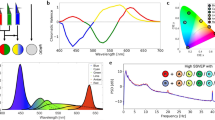Abstract
Background
In multifocal flicker stimulation, each step of the M-sequence consists of four consecutive flashes with a frequency of 30 Hz. The resulting amplitudes can be calculated by means of a discrete fourier transformation (DFT). With this method, amplitudes can be calculated without having to localise peaks and troughs and set cursors. The purpose of this study is to compare the re-test stability of this method to conventional mfERG stimulation.
Methods
We examined 27 healthy subjects using a RETI-scan device (Roland Consult, Wiesbaden). We used 61 hexagons within a 30 deg. visual field. We compared the classic first order kernel (FOK) stimulation with the multifocal 30 Hz Flicker (mfFlicker-ERG) stimulation. Repeatability was calculated using coefficients of variation.
Results
Both methods had coefficients of 15% for the sum P1-amplitude and the DFT results, respectively. The amplitudes calculated by flicker and DFT were approximately 25% smaller than the FOK amplitudes.
Conclusions
This study showed no difference of re-test repeatability between the mfFlicker-ERG and the conventional first order kernel method. Since the mfFlicker-ERG method does not require a definition of peaks and troughs in order to calculate the amplitudes, we believe that a common source of error is eradicated, especially when dealing with distorted or atypical curves.








Similar content being viewed by others
References
Bearse MA Jr, Sutter EE (1996) Imaging localized retinal dysfunction with the multifocal electroretinogram. J Opt Soc Am A 13:634–640
Birch DG, Anderson JL (1992) Standardized full-field electroretinography. Normal values and their variation with age. Arch Ophthalmol 10:1571–1576
Bush RA, Sieving PA (1996) Inner retinal contributions to the primate photopic fast flicker electroretinogram. J Opt Soc Am A Opt Image Sci Vis 13(3):557–565. Mar
Curcio CA, Sloan KR, Kalina RE, Hendrickson AE (1990) Human photoreceptor topography. J Comp Neurol 292:497–523
Hare WA, Ton H (2002) Effects of APB, PDA, and TTX on ERG responses recorded using both multifocal and conventional methods in monkey. Effects of APB, PDA, and TTX on monkey ERG responses. Doc Ophthalmol 105(2):189–222. Sep
Hood DC, Greenstein V, Frishman L, Holopigian K, Viswanathan S, Seiple W, Ahmed J, Robson JG (1999) Identifying inner retinal contributions to the human multifocal ERG. Vision Res 39(13):2285–2291. Jun
Hood DC, Seiple W, Holopigian K, Greenstein V (1997) A comparison of the components of the multifocal and full-field ERGs. Vis Neurosci 14:533–544
Hood DC (2000) Assessing retinal function with the multifocal technique. Prog Retin Eye Res 19(5):607–646. Review. Sep
Jacobi PC, Miliczek KD, Zrenner E (1993) Experiences with the international standard for clinical electroretinography: normative values for clinical practice, interindividual and intraindividual variations and possible extensions. Doc Ophthalmol 85(2):95–114
Kondo M, Miyake Y, Horiguchi M, Suzuki S, Tanikawa (1995) Clinical evaluation of multifocal electroretinogram. Invest Ophthalmol Vis Sci 36:2146–2150
Parks S, Keating D, Williamson TH, Evans AL, Elliott AT, Jay JL (1996) Functional imaging of the retina using the multifocal electroretinograph: a control study. Br J Ophthalmol 80:831–834
Sutter EE, Tran D (1992) The field topography of ERG components in man–I. The photopic luminance response. Vision Res 32:433–446
Velten IM, Horn FK, Korth M (2002) [Multifocal ERG with 30 Hz flicker stimulation in glaucoma patients and normal probands]. Ophthalmologe 99(6):432–437. Jun
Author information
Authors and Affiliations
Corresponding author
Rights and permissions
About this article
Cite this article
Mazinani, B.A.E., Repas, T., Weinberger, A.W.A. et al. Amplitude calculation in multifocal ERG: comparison of repeatability in 30 Hz flicker and first order kernel stimulation. Graefe's Arch Clin Exp Ophthalmol 245, 338–344 (2007). https://doi.org/10.1007/s00417-006-0423-2
Received:
Revised:
Accepted:
Published:
Issue Date:
DOI: https://doi.org/10.1007/s00417-006-0423-2




